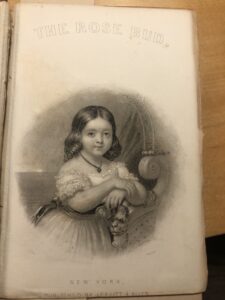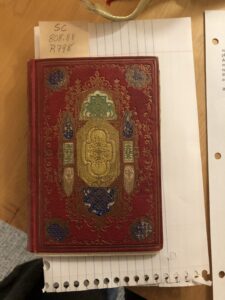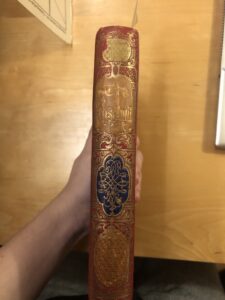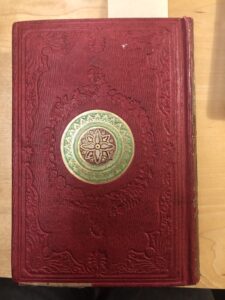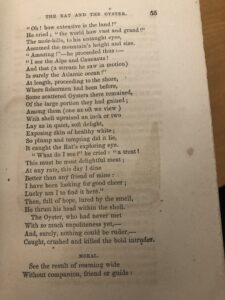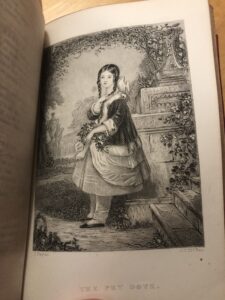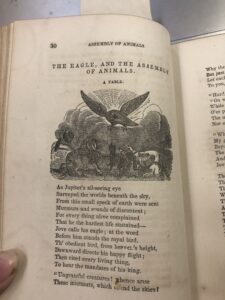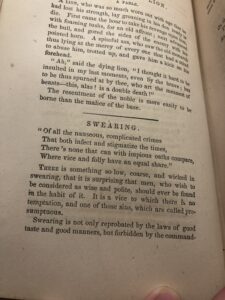The Rosebud is a fascinating aspect of a practice that has been rendered obsolete and lost to time. This book is an example of a “gift book” or “annual”, which were typically illustrated collections of poetry, fables and prose, popular in the 19th century (A 19th-Century Fad). As a point of clarification, though the terms “gift book” and “annual” are often used interchangeably, a small difference exists in that “annuals” refers to editions of any such anthology of different works or magazines with extra aspects or illustrations printed for purchase at the end of the year (Gift Books and Annuals | Encyclopedia.Com). The main draw of these gift books was that the covers were lavishly decorated, with gilt edges and ornately decorated binding. The Rosebud’s bright colors and intricately embossed cover and spine designs make it a shining example of such a book. These annuals often served as gifts for women and children, with The Rosebud likely intended as a romantic gesture, due to its name representing a flower. Flower language was a popular method of courtship in this era (The American Gift Book). Gift books also served to further political causes, with a number of abolitionist gift books being circulated between 1839-1857 (Gift Books and Annuals | Encyclopedia.Com).
Gift books hit the peak of their popularity in 1848 to 1851, with thousands of copies of certain popular annuals such as The Atlantic Souvenir being circulated throughout England, the United States, and later to Canada and South America (The American Gift Book). In the 1850’s however, the popularity of gift books began to decline. Because The Rosebud was published sometime in the 1850’s, it was one of the later gift books to be circulated. This possibly explains why there is so little information on The Rosebud itself online, as it was likely not particularly popular due to the gift book’s waning relevance as a genre. The downfall of annuals and gift books was likely caused by a number of factors. Importantly, publishers had begun to employ marketing strategies such as publishing their gift books just before the Christmas season, thus creating intense competition between publishers. Additionally, those authors that gained notoriety from their writing contributions to gift books began to publish their writing independently, both exceeding the popularity of gift books and effectively rendering the content within them redundant and unnecessary (The American Gift Book). Ultimately, they simply grew out of fashion in the late 1850’s, with little to none still being published by the time of the Civil War.
In terms of the fate of this edition of The Rosebud, there is some information that can be gleaned from its appearance. Firstly, the interior appears to be almost completely free of damage. This is not uncommon in gift books, as their purpose was not necessarily to be read as you would a typical book. Instead, they were similar in concept to today’s coffee table books, intended to be displayed on tables and shelves, and to be flipped through at random. The Rosebud falls in line with this purpose, as the writing and poetry segments are not in any particular order.
Another aspect that was common with gift books is that the engravings contained within them were often removed and displayed, due to their beauty and detail. An interesting detail to note is that this particular edition of The Rosebud has all of its illustrations intact, perhaps lending credence to the fact that The Rosebud was not a popular or well known gift book.
It is not readily known how many editions of The Rosebud were printed, but according to The Arsenical Books Database, at least two editions were bound with a green onlay containing a small amount of arsenic. This was a somewhat common practice in the 19th century, as the bindings and onlays containing this arsenic were a brilliant, beautiful green color, making books that utilized it stand out from others (ARSENICAL BOOKS DATABASE – Winterthur Museum, Garden & Library). According to the database, the method in which the arsenic was applied was an ornamental onlay similar to that of this edition of The Rosebud, so it is not completely out of the realm of possibility that this edition contains arsenic. It is not likely that The Rosebud was ever reprinted any later than the short time it was in circulation, as it was published at the tail end of the lifespan of the gift book. It has not been scanned online, and there are few sporadic editions available for online purchase on sites such as Etsy.
In short, the specific details of the afterlife of this edition of The Rosebud remain mysterious. It emerged towards the downfall of the gift book’s cultural relevance, and faded quickly into obscurity. Its contents and illustrations have been seen by relatively few, and information is sparse. Ultimately, it serves as a marker of a unique cultural practice of the 19th century, and an ancestor to modern coffee table books, meant to be looked at rather than read.
Works Cited
